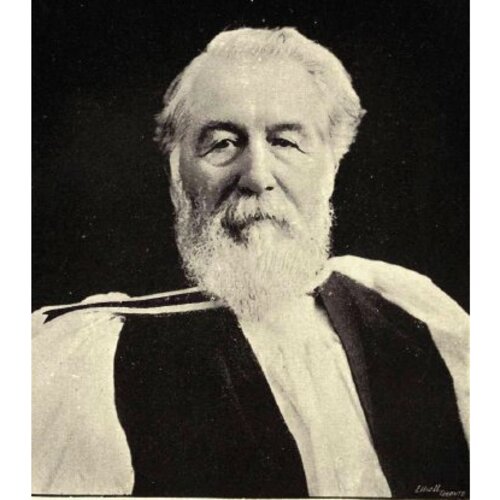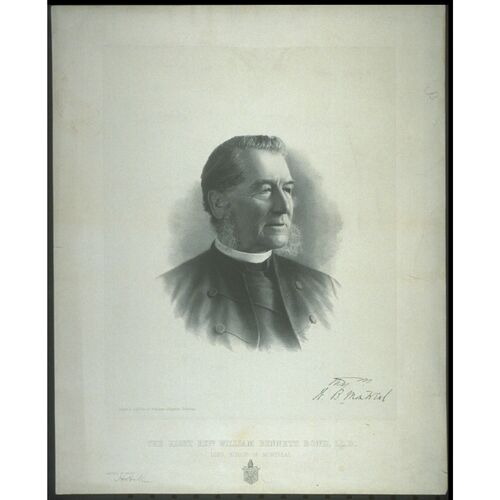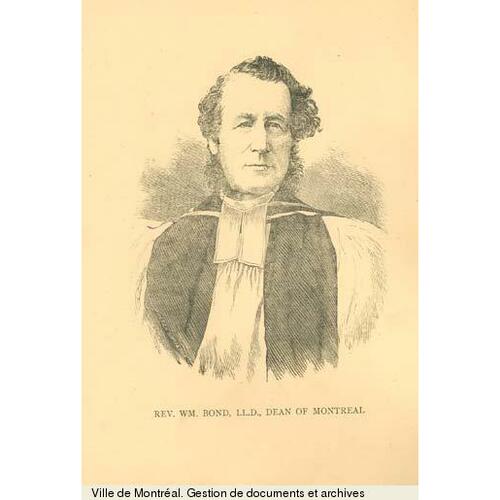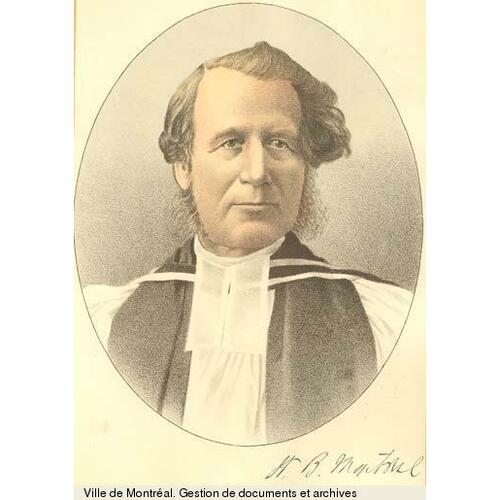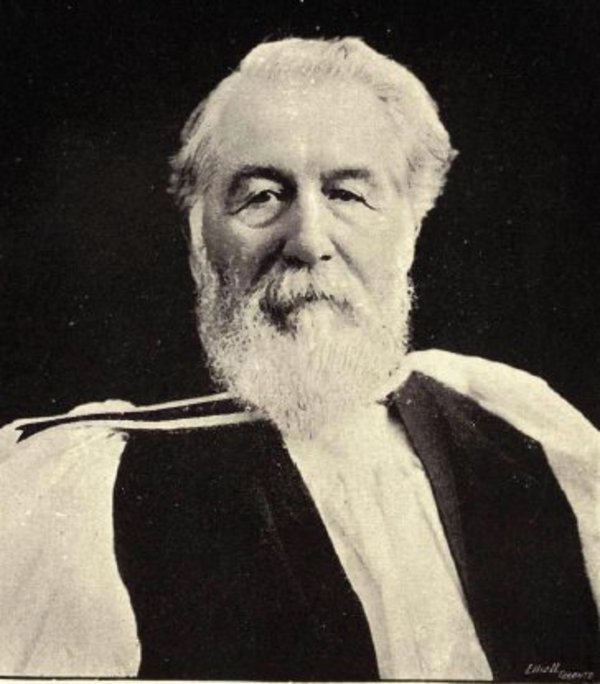
Source: Courtesy of Wikimedia Commons
BOND, WILLIAM BENNETT, Church of England priest and archbishop; b. 10 Sept. 1815 in Truro, England, son of John Bond, a soldier, and Nanny Bennett; m. 4 June 1841 Eliza Langley in St John’s, and they had four sons and two daughters; d. 9 Oct. 1906 in Montreal.
The eldest of 12 children, William Bennett Bond was educated at Calday Grammar School, West Kirby (his family having moved to nearby Hoylake), and later in London. At age 17 he left England to work in business at St John’s, Nfld. There, he was influenced by two men, the Reverend Thomas Finch Hobday Bridge*, curate to the rector of St John’s, and Mark Willoughby*, superintendent of the Newfoundland School Society for the island. In theory an Anglican organization, this society, founded in 1823, provided education with a religious orientation. It was resolutely evangelical in ethos and frequently employed non-Anglicans in its schools, its activities sometimes marked by a rather militant opposition to the leaders of the church.
Bond joined Willoughby’s Bible class in St John’s. Under the direction of Bridge and no doubt encouraged by Willoughby, he began to read for ordination. Willoughby moved to Lower Canada in 1839, and it was probably he who persuaded Bond to present himself as a candidate for ordination to the bishop of Quebec, George Jehoshaphat Mountain*. On 21 June 1840 Bond was ordained deacon in the Cathedral of the Holy Trinity, Quebec City. His first post was that of travelling missionary based at Russeltown Flats and at Napierville; during his two years in the region he journeyed widely to hold services for the scattered population. He also established a number of missions and, according to one source, founded 11 schools in Hemmingford Township alone. In this work he acted as an agent of the Newfoundland School Society (known as the British North America School Society in the Canadas). On 17 Oct. 1841 he was ordained priest by Mountain in Willoughby’s church, Trinity Chapel, Montreal. His activities as travelling missionary were to be characteristic of his entire ministry: the building up of the church by founding congregations, schools, and organizations. He would always be closely associated with the work of the Newfoundland School Society (later known as the Colonial Church and School Society).
In 1842 Bond was appointed incumbent of St Stephen’s Church, Lachine. The following year Mountain reported that Bond held three services on Sunday, in the morning and evening at the church and in the afternoon at a location five miles away. On Thursday evenings he officiated in a store two and a half miles from the church. By July 1845 there were three schools in operation in the parish, two under the charge of government school commissioners and one under the British North America School Society. Bond’s congregation consisted of 211 members and about 40 soldiers. In the early months of his ministry at Lachine, he baptized his first child, William Willoughby, one of whose godfathers was Bond’s long-time friend and mentor.
From Lachine, Bond went in 1848 to St George’s Church, Montreal, as assistant minister. At the same time he replaced Willoughby, who had died the previous year, as superintendent for the Canadas of the Newfoundland School Society. St George’s rector, the Reverend William Turnbull Leach*, was also vice-principal of McGill College, so the greater part of the parochial responsibilities fell to Bond. He was to be at St George’s until 1878 and there he did some of his most enduring work. In 1863 he succeeded Leach as rector. The same year he was named rural dean of Hochelaga; in 1866 canon of Christ Church Cathedral, Montreal; in 1870 domestic chaplain to the bishop of Montreal, Ashton Oxenden*, and archdeacon of Hochelaga; and in 1872 dean of Montreal. Bond received an honorary ma from Bishop’s College in 1854 (and subsequently a dd and dcl) as well as an lld from McGill College in 1870. He was chaplain to the 1st (Prince of Wales’s) Regiment of Volunteer Rifles and went with it to the Eastern Townships in 1866 and 1870 during the Fenian raids. In 1898 he became honorary captain and chaplain of the regiment.
During Bond’s rectorship, St George’s became one of the most important parishes in the diocese and in the country. In 1866 a decision was made to build a new church and the present St George’s on Dominion Square was opened in 1870. Many of the leading members of the English-speaking business and professional communities worshipped there. Bond was able to call on the assistance of men such as Andrew Frederick Gault and George Moffatt* in his many undertakings.
His long-standing interest in education found expression in the development of Sunday schools, of which St George’s soon became one of the largest in the city. He closely supervised the lay teachers’ weekly meeting in order to help them prepare their lessons. Temperance was another of his interests. He signed the pledge himself and St George’s Temperance Society and the Band of Hope for young people were soon organized. As well, Temperance House was established in Verdun for the care and cure of inebriates. Bond founded the St George’s Young Men’s Christian Association as a way of directing the enthusiasm of the young men of the congregation. They visited hospitals, they rented rooms in which to conduct Sunday schools and services in the outlying areas of the city, and when the need arose they raised money to erect and furnish new churches. Before the end of the century, at least six Montreal parishes owed their origins to the work of the St George’s YMCA. In addition to these activities, St George’s parish was an important contributor of both money and effort to the missionary endeavours of the diocese.
Bond was especially fortunate in his assistant ministers. When he became rector in 1863 the Reverend Edward Sullivan*, later bishop of Algoma, had just been appointed assistant. He stayed until 1868, and returned as rector in 1879 after Bond had been raised to the episcopate. Sullivan’s successor in 1868 was the Reverend James Carmichael. He left in 1878 and returned as rector in 1882. One of Bond’s most trusted advisers, he would be elected coadjutor bishop in 1902 and would become bishop of Montreal on Bond’s death. Both men were famous preachers and did much to further Bond’s activities and establish the stature of St George’s. Bond worked well with them and had no fear of lessening his own position in giving full rein to their talents.
Bond was as active in diocesan affairs as he was in parochial ones. When the synod of the diocese of Montreal was being organized in the late 1850s, Bond resolutely opposed the inclusion by Bishop Francis Fulford* of an episcopal veto in the constitution and canons of the diocese. His attitude to the governance of the church had been stated when he moved acceptance of the report of the Church Society of the Diocese of Montreal in 1857. “I argued that the Society was not conducted as I wished, but I said: well, I will join it, and try if I cannot effect a reform.” Bond felt the same way about the synod: he tried to reform it from within. He was a member of its first three executive committees, from 1859 to 1861; when after years of suspension the committee was re-established in 1868, he became a member again, and he would remain one until elected to the episcopate. He was also active on many of the other committees of synod, including those on finance, foreign missions, the diocesan court, and in particular temperance.
Bond was usually a clerical delegate to the synod of the ecclesiastical province of Canada. The province had been created in 1860 by letters patent with the bishop of Montreal, Fulford, and his successors as metropolitan. The election of the metropolitan was to cause many difficulties. The right of nomination had been vested in the house of bishops of the province and, not unexpectedly, Bond opposed this provision, believing that the diocese of Montreal should elect its own bishop. The problem was finally resolved in 1878. The house of bishops declined to nominate on the resignation of Bishop Oxenden and the diocese elected Bond third bishop of Montreal. The house of bishops then chose the bishop of Fredericton, John Medley*, as metropolitan the following year. Although many Montreal churchmen continued to push Montreal’s claim to the metropolitan dignity, in fact the issue was closed and the new procedure of separate elections was embodied in the canons. This result was due, in large part, to Bond’s refusal to pursue the question.
The election of Bond as bishop of Montreal on 16 Oct. 1878 represented another important change in that, unlike his predecessors, English priests who had been consecrated in England before coming to British North America, Bond had spent his priesthood in Lower Canada, especially in the region of Montreal. Bond was to be a particularly Canadian and, indeed, Montreal bishop, one whose horizons were largely bounded by the diocese of Montreal. He was consecrated in his former church, St George’s, on 25 Jan. 1879 by Medley, assisted by Hibbert Binney*, bishop of Nova Scotia, John Travers Lewis, bishop of Ontario, James William Williams*, bishop of Quebec, Thomas Brock Fuller*, bishop of Niagara, and Frederick Dawson Fauquier*, bishop of Algoma.
The focus of Bond’s episcopate was the development of the church in the diocese of Montreal, its clergy, congregations, and institutions. One of his first concerns was to re-establish its financial stability, weakened by the economic depression of the late 1870s. In particular, the stipends of rural missionaries were a pressing problem. The welfare of these clergymen, both physical and spiritual, was to preoccupy him during most of his episcopate. He would not accept that they and their families should be ground down by poverty and overwork. Nor was he prepared to send additional missionaries to ease the workload until he could guarantee adequate stipends. Furthermore, the low stipends tempted some clergy to leave the diocese for better-paying positions elsewhere. Bond strongly advocated the adoption of a centralized system, the “Quebec scheme” [see James William Williams], in which the total stipend of missionary clergy was paid by the diocese, not partly by the congregation and partly by the diocese. The congregation’s share under this plan was given directly to the diocese. The hope was that such an arrangement would ensure the payment of the full stipend. The method was adopted only in 1895, however.
His concern for the material well-being of his clergy was just one side of Bond’s pastoral relationship with them. He was equally interested in their spiritual welfare, and to this end he promoted study and clerical conferences during which they could meet for mutual support and edification. He developed close, lasting relationships with some of his clergy, in particular Carmichael and the Reverend William Herbert Naylor.
Bond’s care for the clergy was in part a reflection of his concern for the laity; provision of the services of the church and spiritual oversight of the diocese were his constant aims. From the first year of his episcopate, he made it a practice to visit each congregation on an almost yearly basis. Given the size of the diocese, this entailed ceaseless travelling until the end of his life. In 1905, for example, he confirmed 552 people and visited the archdeaconries of Clarendon and St Andrews (Saint-André-Est). In Clarendon he held services in 10 churches in little over a week. This constant and regular visiting established a special relationship between the bishop and his flock that contributed to the strengthening of the corporate life of the church.
Not only did Bond foster strong ties of affection throughout the diocese, but he drew around him many leading laymen whose financial and moral support was invaluable in the development of institutions, particularly the ones the church considered necessary to assist those in need. As bishop, Bond was ex officio president of several charities: the Church Home, for “ladies” and “women of education,” which dated from 1855; the Andrews Home, where the diocese centralized its immigrant aid programs, founded in 1895 with a large bequest from Montreal lawyer Henry Ogden Andrews; and the Robert Jones Memorial Convalescent Hospital for children, established at Lachine in 1893. Beyond these church institutions, he was a governor of the Protestant Hospital for the Insane, at Verdun, a vice-president of the Montreal Auxiliary Bible Society, and a founder of the Citizens’ League of Montreal in 1888.
Although the church had slowly relinquished any direct responsibility for education, this subject was never very far from view. Dunham Ladies’ College was one of only a few truly church schools still in existence during his episcopate. Another, and more important, school was the Sabrevois mission. This mission to the French Canadians, moved to Montreal from Sabrevois in 1880, had the active support of Bond and the Colonial Church and School Society, whose local chairman was the bishop. But the most important educational institution in the diocese was the Montreal Diocesan Theological College. Founded in 1873 by Oxenden, it was incorporated in 1879 and affiliated to McGill College with the bishop as president. Here most of the clergy of the diocese were trained. Through the generosity of Andrew Frederick Gault, a first building was acquired, and in 1896 the present building on Rue University was constructed by Gault and given with an endowment to the bishop. The instruction given at the college reflected the conservative evangelical theology of the diocese and of Bond.
Bond maintained throughout his life the theological teaching he had received as a young man. He was not influenced by the Oxford movement of the 1830s and 1840s except to reject what appeared to him as “Romanism,” nor was he influenced by the new theological developments associated with the “higher criticism” of the second half of the 19th century. Although a foe of “ritualism,” Bond could recognize that “ritualists” were not necessarily disloyal to the church. During his episcopate the long wrangle in the diocese between the low church and high church parties over ritual, if it did not cease, at least came to have a less prominent place in local church life, largely owing to his influence and example. He gladly consecrated the Church of St John the Evangelist, Montreal, the “catholic” parish of the diocese, in 1905. In 1897 he had made its rector, the Reverend Edmund Wood, a canon of the cathedral.
In strictly theological matters Bond was less accommodating. Late in 1900 or early in 1901 concern arose at the Montreal Diocesan Theological College over the teachings of the Reverend Frederick Julius Stem, professor of ecclesiastical history and apologetics. A committee of inquiry appointed by the governors reported that Stem’s views were unacceptable. Stem’s resignation was immediately accepted and he was inhibited from performing any clerical function in the diocese, including preaching. The ensuing controversy spilled into the public press. Not all church members found Stem’s teaching unacceptable, although there was a noticeable lack of support from the clergy. Bond believed that Steen would be happier elsewhere, outside the diocese of Montreal. But, in fact, he was appointed assistant at Christ Church Cathedral, where he remained until his death in 1903. Reports of the controversy would seem to indicate that Steen had been introducing his students to “higher criticism” even though he may not have endorsed any or all of its conclusions. This innovation was too much for the college’s conservative authorities and for the elderly bishop.
It was not only theologically that the diocese under Bond remained somewhat outside the mainstream of church life. Bond attended neither of the Lambeth conferences of Anglican bishops held during his episcopate. Although he supported the encyclicals they issued in 1888 and 1897, he felt that he had little to contribute to the deliberations and that his first duty was to his diocese. In this respect he was far more the bishop of Montreal than a bishop of the church. His belief in diocesan autonomy influenced his views on the unification of the dioceses of British North America into a national church. Although delegates from Montreal went to the Winnipeg conference of 1890 to discuss a “scheme” for a general synod for Canada, Bond’s support was less than enthusiastic. When the general synod was formed in 1893, however, the diocese of Montreal was one of the uniting dioceses. Bond’s election in 1901 as metropolitan of the ecclesiastical province of Canada, a dignity he had not wanted to fight for in 1879, was a recognition of his position as the senior bishop and not a recognition of Montreal’s position within the province. (On becoming metropolitan he was also made archbishop of his see.) Similarly, his election as the second primate of the Canadian church in 1904, in succession to Archbishop Robert Machray of Rupert’s Land, was a personal honour and did not represent any marked change in his views on the general synod.
By 1900 it was increasingly clear that Bond was becoming too old to administer the diocese without assistance. He had had a serious illness in 1893 and in the following years had needed help in carrying out his regular program of visitations. Beginning in 1902 his coadjutor, Carmichael, slowly took over many of the bishop’s duties, but Bond was still able to fulfil some responsibilities. His death in 1906 in his 92nd year marked the end of a life of dedicated service to his church and his Lord.
All contemporary accounts of Bond speak of his commanding presence. He was over six feet tall and was broadly proportioned, with piercing eyes and a resounding voice that was used to much effect in the pulpit. According to one of his biographers, “he was eminently a manly man” and to those who knew him his apparent severity hid a warm and deep sympathy. He was both a man of work and a man of prayer. His personality attracted some of the leading clergy and laity to his support. Furthermore, he developed good relations with other churches. When he was ill in 1893, prayers were offered for him in the Roman Catholic churches of Montreal. Finally, it was Bond’s unceasing labour as bishop that at last firmly established the diocese of Montreal both financially and spiritually. Perhaps no other man could have so completely embodied the conservative evangelical, but at the same time practical, ethos of Montreal Anglicanism of the latter half of the 19th century.
William Bennett Bond is the author of Sermons preached in Trinity Church, Montreal, on the occasion of the death of the Rev. Mark Willoughby, incumbent (Montreal, 1847) and Sermon preached in St. George’s Church, Montreal, on the 9th April, 1854, on behalf of the Ladies’ Benevolent Institution (Montreal, 1854).
AC, Montréal, État civil, Anglicans, Christ Church (Montreal), 12 Oct. 1906. ACC, Diocese of Montreal Arch., W. B. Bond papers; W. H. Naylor papers. McGill Univ. Libraries (Montreal), Dept. of Rare Books and Special Coll.,
Cite This Article
Richard Virr, “BOND, WILLIAM BENNETT,” in Dictionary of Canadian Biography, vol. 13, University of Toronto/Université Laval, 2003–, accessed April 17, 2025, https://www.biographi.ca/en/bio/bond_william_bennett_13E.html.
The citation above shows the format for footnotes and endnotes according to the Chicago manual of style (16th edition). Information to be used in other citation formats:
| Permalink: | https://www.biographi.ca/en/bio/bond_william_bennett_13E.html |
| Author of Article: | Richard Virr |
| Title of Article: | BOND, WILLIAM BENNETT |
| Publication Name: | Dictionary of Canadian Biography, vol. 13 |
| Publisher: | University of Toronto/Université Laval |
| Year of revision: | 1994 |
| Access Date: | April 17, 2025 |


